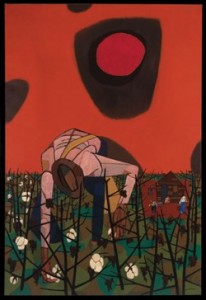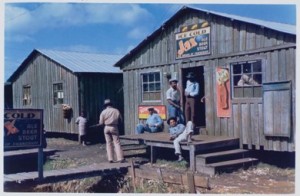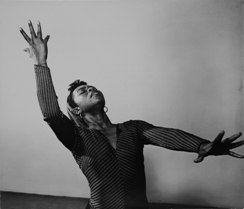
Robert Gwathmey (American, 1903–1988), Sun-Up, ca. 1948, oil on canvas, Williams College Museum of Art
(WILLIAMSTOWN, Mass.) – On view at the Williams College Museum of Art (WCMA) from January 14 to April 22, 2012, African Americans and the American Scene, 1929–1945 explores the role of African Americans in the visual and performing arts during the Great Depression. On Thursday, February 16, there will be a multidisciplinary gallery talk at 4:30 pm followed by a public reception from 5:30 to 7:30 pm. These events are free and open to the public.
African Americans and the American Scene focuses on the Depression era. Shaken by the economic collapse, the United States experienced a profound crisis of national identity during the Great Depression. Artists began to picture the “American Scene,” subjects culled from daily life such as farms, labor, picnics, and landscapes.
African American culture was used as source material for depicting the American Scene. Furthermore, federal funding for the arts during the depression provided opportunities for white and black artists alike. Through visual art, dance, and film, African Americans and the American Scene endeavors to sift though the complexities of racial representation in art and the social inclusion and exclusion that affected black artists and performers’ access to their medium of choice.

Marion Post Wolcott (American, 1910–1990), Living Quarters and “Juke Joint” for Migratory Workers, a Slack Season
Artists featured in this exhibition include Thomas Hart Benton, Walker Evans, Robert Gwathmey, Dorothea Lange, Aaron Siskind, and Marion Post Wolcott. Artwork by African American artists Samuel Brown, Jacob Lawrence, and William H. Johnson will highlight the ways that black artists engaged with the American Scene movement. The visual art from the 1930s and 40s will be paired with Barbara Morgan’s photographs of African American modern dancer Pearl Primus and artistic storyboards from the film Emperor Jones, starring Paul Robeson.
Co-curated by Dalila Scruggs, Ph.D., Mellon Curator for Diversity in the Arts, and Sandra Burton, Lipp Family Director of Dance at Williams College, African Americans and the American Scene underscores the Williams College Museum of Art’s commitment to multidisciplinary approaches to looking and thinking about art. A variety of programs and events connecting visual and performing art are planned for students and the general public for the duration of the exhibition.

Barbara Morgan (American, 1900–1992), Pearl Primus, Speak to Me of Rivers (1), 1944, Silver gelatin print (printed 1970s – 1980s)
“What American artists created from 1929 to 1945 resonates now because the work represents a close examination of who we were then, and are still in the process of becoming,” explains co-curator Sandra Burton. “Collaborating on this exhibition deepened my belief in the performing and visual arts as important historical documents.”
“I’m excited to present an exhibition that examines an era where art and political activism were so passionately intertwined,” expressed co-curator Dalila Scruggs. “The work from the depression-era is especially timely given the country’s current economic problems and political movements like the Ninety-nine percenters.”
Related Programming
Gallery Talk: African Americans and the American Scene
Monday, January 16 at 1:45 p.m. (galleries open at 1:15pm)
Williams College Museum of Art
A conversation with the curators and Alex Willingham, Professor of Political Science, held in collaboration with the Multicultural Center in honor of Martin Luther King Day.
Book Reading: Pearl Primus: Life, Work, and Legacy
Friday, January 20 at 6 p.m.
Presented at the Dance Studio, ‘62 Center for Theatre and Dance
Authors Peggy and Murray Schwartz and guest artists explore the work of Pearl Primus in a program of dance, media, and dialogue.
Multidisciplinary Gallery Talk: African Americans and the American Scene
Thursday, February 16 at 4:30 p.m.
Williams College Museum of Art
Four different perspectives on the issues presented in this exhibition. With co-curator Dalila Scruggs, Mellon Curator for Diversity in the Arts; co-curator Sandra Burton, Lipp Family Director of Dance and Senior Lecturer in Dance; Leslie Brown, Associate Professor of History; and Vince Schleitwiler, Assistant Professor of English.
360 Dance Company: Dialogues in Dance
Wednesday, April 4
Williams College Museum of Art
Exhibition Viewing: African Americans and the American Scene at 6:00 p.m.
Performance in the Galleries at 7 p.m.
Explore the artistic innovations in modern dance from the 1930s and 40s through performance and discussion with 360º Dance Company, a New York City-based troupe comprised of former principal dancers of the Martha Graham Dance Company.
Dance Workshop with 360º
Thursday, April 5 from 4-6:30 p.m.
Held at the Dance Studio, ’62 Center for Theatre and Dance
Come learn Jane Dudley’s Time is Money (1934), a solo that explores oppression of the worker in society, performed to leftist poetry and set in the Depression era. Open to movers from a variety of backgrounds, male and female, including actors, dancers, and other performers. Taught by 360º Dance Company.
Pre-registration required. Call the box office at 413.597.2425.
The Williams College Museum of Art
The Williams College Museum of Art is located on Main Street in Williamstown, Mass. It is open Tuesday through Saturday from 10 a.m. to 5 p.m. and Sunday from 1 to 5 p.m. The museum is wheelchair accessible and open to the public. Admission is free. For more information, contact the museum at 413.597.2429 or visit Williams College Museum of Art (WCMA).
